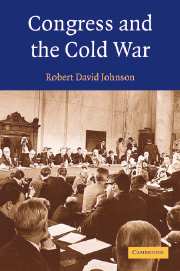Book contents
- Frontmatter
- Contents
- Abbreviations Used in the Text
- Acknowledgments
- Prologue
- Archives Consulted
- Congress and the Cold War
- 1 Constructing a Bipartisan Foreign Policy
- 2 Legislative Power and the Congressional Right
- 3 Redefining Congressional Power
- 4 The Consequences of Vietnam
- 5 The Transformation of Stuart Symington
- 6 The New Internationalists' Congress
- 7 The Triumph of the Armed Services Committee
- Appendix A The Foreign Aid Revolt of 1963
- Appendix B The Senate and U.S. Involvement in Southeast Asia, 1970–1974
- Appendix C The Senate of the New Internationalists, 1973–1976
- Appendix D The House and the End of the Cold War, 1980–1985
- Index
1 - Constructing a Bipartisan Foreign Policy
Published online by Cambridge University Press: 05 June 2012
- Frontmatter
- Contents
- Abbreviations Used in the Text
- Acknowledgments
- Prologue
- Archives Consulted
- Congress and the Cold War
- 1 Constructing a Bipartisan Foreign Policy
- 2 Legislative Power and the Congressional Right
- 3 Redefining Congressional Power
- 4 The Consequences of Vietnam
- 5 The Transformation of Stuart Symington
- 6 The New Internationalists' Congress
- 7 The Triumph of the Armed Services Committee
- Appendix A The Foreign Aid Revolt of 1963
- Appendix B The Senate and U.S. Involvement in Southeast Asia, 1970–1974
- Appendix C The Senate of the New Internationalists, 1973–1976
- Appendix D The House and the End of the Cold War, 1980–1985
- Index
Summary
Serious congressional planning for the postwar world dated from Senate consideration of the B2H2 resolution in 1943. Named for its original four sponsors – Joseph Ball (R-Minnesota), Harold Burton (R-Ohio), Carl Hatch (D-New Mexico), and Lister Hill (D-Alabama) – the resolution sought to commit the United States to membership in a postwar international organization that included a police power. When Foreign Relations Committee chairman Tom Connally (D-Texas) countered with a vaguely worded offering that urged U.S. membership in a postwar “international authority” of “free and sovereign nations,” a Senate debate about how the United States should respond to the postwar environment erupted.
Connally chaired the “Committee of Eight,” a special subcommittee created to institutionalize informal cooperation between the administration and the Senate and thereby avoid the institutional tensions that had doomed the Treaty of Versailles in 1919. The thin-skinned Connally, faced with legitimate questions about his resolution's unclear wording, complained about the “debate degenerating into a heckling of the chairman of the committee”; Allen Drury, who covered the wartime Senate for the New York Times, perceived that “the gap between the Foreign Relations chairman and the Senate which he must persuade is becoming steadily wider.” The Texas senator's political and personal shortcomings highlighted the significance of Michigan senator Arthur Vandenberg, who Francis Wilcox, the Foreign Relations Committee's chief of staff, termed the “indispensable element” in the Senate's response to postwar foreign policy.
- Type
- Chapter
- Information
- Congress and the Cold War , pp. 1 - 34Publisher: Cambridge University PressPrint publication year: 2005



